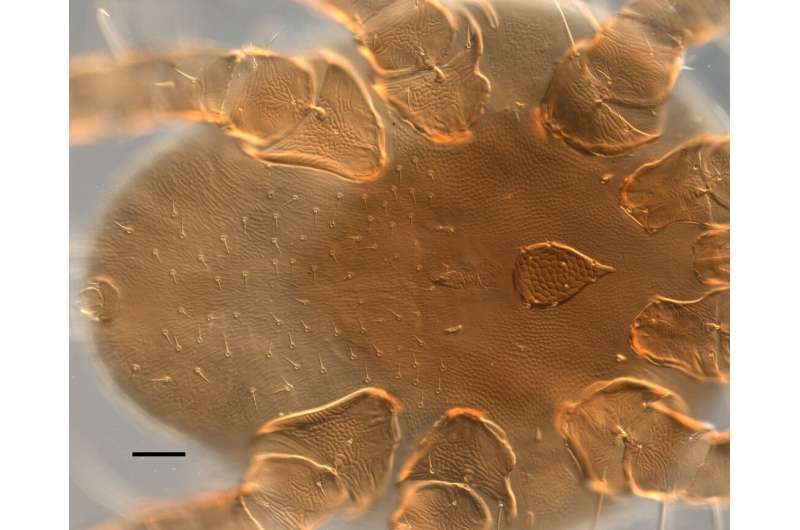Spinturnix scuticornis (Acari: Spinturnicidae) Credit: Credit by Maria Orlova
TSU biologist Maria Orlova has discovered an extremely rare species of parasite, Spinturnix scuticornis (Acari: Spinturnicidae). The invertebrate was taken from a Himalayan bat caught in Vietnam, where the bat is widespread. This is the first find for the Republic of Vietnam and the fourth in the world. The detection was also unusual—an unidentified tick was found among the parasites stored in the Zoological Museum of Moscow State University. The research results are published in the International Journal of Acarology.
"2020 has limited the possibility of field trips, and each missed field season is a big loss for the researcher. To somehow compensate it, we decided to turn to the existing collections," says Maria Orlova, a TSU Laboratory of Biological Diversity Monitoring staff member. "My colleague and co-author Sergei Kruskop invited me to work with the collection of bats at the Moscow State University Zoological Museum. At first, it was pure adventurism. There were no guarantees that the parasites would end up on animals, but I made a bet that ticks cling tightly to their hosts, remain in the fur and folds of the wings of even dead animals, and even, as in our case, are found among already collected fly bloodsuckers."
The identification of the specimen, which had been stored for over 20 years in an alcohol solution, showed that it was the Spinturnix scuticornis mite (Acari: Spinturnicidae). According to the documentation, the parasite was removed from the Himalayan bat (Myotis siligorensis). Previously, this tick was described in Afghanistan, then collected in China, and there is another registration in Azerbaijan that is not yet fully confirmed. The biology of this tick has not yet been studied, and even its primary host is unknown. However, for the species of the genus Spinturnix, the possibility of their transferring such bat pathogens as Bartonella, Anaplasma and Rickettsia has been described. Their danger to humans remains unexplored, but it is not excluded.
"Southeast Asia still contains a lot of unexplored areas, Vietnam is no exception," says Maria Orlova. "Unfortunately, our knowledge about bat parasites (both macroparasites—ticks, fleas, bloodsuckers, and microparasites—bacterial, viral, and other pathogens) is still far from exhaustive, which the pandemic has confirmed. In the course of working with the collection of bats at Moscow State University, it was possible to collect excellent material, including from bats that had been stored in the zoological museum for several decades. The data obtained from that research will be presented in a series of articles devoted to mites associated with Vietnamese bats."
Credit: TSU
More information: Maria V. Orlova et al. First record of the ectoparasitic mite Spinturnix scuticornis (Acari: Spinturnicidae) from the Himalayan whiskered bat Myotis siligorensis (Chiroptera: Vespertilionidae) in Vietnam, International Journal of Acarology (2020). DOI: 10.1080/01647954.2020.1819412
Provided by Tomsk State University

























